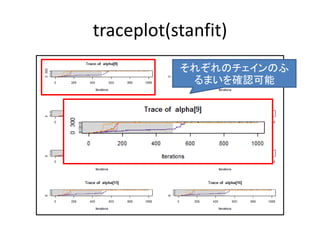StanTutorial
- 2. イントロダクション
- 4. そう、それは
- 5. モデリング
- 6. しかし、それが難しい
- 8. 統計モデリング 銀の弾丸
- 19. Stanチュートリアル
- 20. Stanって何? • StanはHMCをNUTSで実装したサンプラー – 現在も開発、更新が頻繁に行われている。 – Rのインターフェースがあり、使いやすい • とにかく早い – NUTS(HMC)を使用しているため、収束が早い – C++→実行ファイルに変換、計算が早い
- 21. Stanのサンプルコード – BUGSと似ているがより手続き的 # http://www.mrc-bsu.cam.ac.uk/bugs/winbugs/Vol1.pdf # Page 3: Rats data { int<lower=0> N; int<lower=0> T; real x[T]; real y[N,T]; real xbar; } ... model { mu_alpha ~ normal(0, 100); mu_beta ~ normal(0, 100); sigmasq_y ~ inv_gamma(0.001, 0.001); From https://github.com/stan-dev/stan/tree/master/src/models/bugs_examples/vol1/rats
- 24. インストール方法(Windows). 1. Rtoolsをインストール・・・次へ、次へをクリッ クすると入ります。 2. RCppとinlineをインストール・・・PATHの順番 を必ず、RtoolsのPATHが先頭に来るようにし ましょう。 3. Rstanをインストール・・・Rのインストールコー ド実行すると、インストールされ ます。CRANには存在しないので 注意。 参考:Windows8にrstanをインストールする。 http://d.hatena.ne.jp/EulerDijkstra/20130825/1377445438
- 26. ラットデータ • WinBUGS example volume Iに 入っているサンプルデータ (http://www.mrc-bsu.cam.ac.uk/bugs/winbugs/Vol1.pdf) • • • • Gelfand et al (1990) 週別の生後間もないラットの体重のモデル 行:個別のラット(N=30) 列:体重計測日(M=5) From http://www.mrc-bsu.cam.ac.uk/bugs/winbugs/Vol1.pdf
- 27. データを用意します。 rats.data.R N <-30 T <-5 y <-structure(c(151, 145, 147, 155, 135, 159, 141, 159, 177, 134, 160, 143, 154, 171, 163, 160, 142, 156, 157, 152, 154, 139, 146, 157, 132, 160, 169, 157, 137, 153, 199, 199, 214, 200, 188, 210, 189, 201, 236, 182, 208, 188, 200, 221, 216, 207, 187, 203, 212, 203, 205, 190, 191, 211, 185, 207, 216, 205, 180, 200, 246, 249, 263, 237, 230, 252, 231, 248, 285, 220, 261, 220, 244, 270, 242, 248, 234, 243, 259, 246, 253, 225, 229, 250, 237, 257, 261, 248, 219, 244, 283, 293, 312, 272, 280, 298, 275, 297, 350, 260, 313, 273, 289, 326, 281, 288, 280, 283, 307, 286, 298, 267, 272, 285, 286, 303, 295, 289, 258, 286, 320, 354, 328, 297, 323, 331, 305, 338, 376, 296, 352, 314, 325, 358, 312, 324, 316, 317, 336, 321, 334, 302, 302, 323, 331, 345, 333, 316, 291, 324), .Dim = c(30, 5)) x <- c(8.0, 15.0, 22.0, 29.0, 36.0) ファイルの場所 xbar <-22.0 <Rのライブラリーインストール先>rstan¥include¥ stansrc¥models¥bugs_examples¥vol1¥rats
- 29. ラットモデル • 個体差と時間による成長を取り入れた階層ベイズモ デル Yij : 個体iのj日目の観測データ x j :日数 xbar :日数中央値( 22 ) 日 知りたいの はこれ! i : 個体iの切片 i : 個体iの日数係数 : 全個体共通のバラツキ From http://www.mrc-bsu.cam.ac.uk/bugs/winbugs/Vol1.pdf
- 30. Stanプログラムはブロックからなる • Stanの骨子となるプログラム • modelブロック以外はオプショナル この順は 固定 data { model { ... declarations ... ... declarations ... statements ... } } transformed data { generated quantities { ... declarations ... statements ...... declarations ... statements ... } } parameters { ... declarations ... } transformed parameters { ... declarations ... statements ... }
- 31. Stan Program has specific blocks. data • 入力データの宣言、デー タは最初にロードされる transformed data • データに対してStan側で 変換を行う parameters • 結果として出力するパラ メータを宣言する。
- 34. Stan Program has specific blocks. Transformed • パラメータを変換する Parameters Model Generated Quantities • モデル記述部、必須 • 全ての変数を参照可能。1 サンプルにつき実行される。
- 35. transfromed parametersブロック transformed parameters { 分散を標準偏差 real<lower=0> sigma_y; // sigma in original… に変換 real<lower=0> sigma_alpha; real<lower=0> sigma_beta; sigma_y <- sqrt(sigmasq_y); sigma_alpha <- sqrt(sigmasq_alpha); sigma_beta <- sqrt(sigmasq_beta); }
- 36. modelブロック model { 超パラメータを mu_alpha ~ normal(0, 100); サンプリング mu_beta ~ normal(0, 100); sigmasq_y ~ inv_gamma(0.001, 0.001); sigmasq_alpha ~ inv_gamma(0.001, 0.001); sigmasq_beta ~ inv_gamma(0.001, 0.001); alpha ~ normal(mu_alpha, sigma_alpha); // vectorized 超パラメータを beta~ normal(mu_beta, sigma_beta); // vectorized 用いてパラメータ for (n in 1:N) をサンプリング for (t in 1:T) y[n,t] ~ normal(alpha[n] + beta[n] * (x[t] - xbar), sigma_y); } 個体差を含む体重に誤差を加えてサンプリング
- 38. RStan • Rstan・・・RのStanインターフェース – C++への変換、コンパイルから、実行までを担当 – 結果はstanfit関数に格納 – 可視化の関数あり Rstanまわりの構造 stan () stan () Stan code stanc() C++ code plot() exe stan_model() S4:stanfit sampling() traceplot() extract()
- 39. Rでの実行 #set to dir which contains source file STAN_HOME<-<STAN_HOME> dirpath<-paste0(STAN_HOME, path_to_dir) #load data to list:dat データはリス source(paste0(dirpath, "/rats.data.R")) ト形式でStan dat<-list(y=y, x=x, xbar=xbar, N=N, T=T) に渡せる。 #fit1:to simulate the model as one liner fit1 <- stan(file = paste0(dirpath, "/rats.stan"), data = dat, iter = 1000, chains = 4) apply(extract(fit1)$alpha,2, median) Stanfitクラス、Stanでの実行結果が返される
- 42. 前回のモデルを利用 Once a model is fitted, we can use the fitted result as an input to fit the model with other data or settings. This would save us time of compiling the C++ code for the model https://code.google.com/p/stan/wiki/RStanGettingStarted #fit again using the previous fit result fit3<-stan(fit=fit1, data = dat, iter = 400, chains = 4)
- 43. Rからの並列計算 #parallel processing of library(doSNOW) library(foreach) cl<-makeCluster(4) registerDoSNOW(cl) doSNOWとforeachを使用 4パラで計算 #parallel processing each chain of stan sflist1<-foreach(i=1:10,.packages='rstan') %dopar% { stan(fit = fit1, data=dat, chains = 1, chain_id = i, refresh = -1) } #merging the chains f3<-sflist2stanfit(sflist1) foreachで並列処理、 Stanfitクラスのリストを取得する。 Sflist2stanfitでリストをマージする。
- 44. 結果
- 45. EOF





















![Stanのサンプルコード
– BUGSと似ているがより手続き的
# http://www.mrc-bsu.cam.ac.uk/bugs/winbugs/Vol1.pdf
# Page 3: Rats
data {
int<lower=0> N;
int<lower=0> T;
real x[T];
real y[N,T];
real xbar;
}
...
model {
mu_alpha ~ normal(0, 100);
mu_beta ~ normal(0, 100);
sigmasq_y ~ inv_gamma(0.001, 0.001);
From https://github.com/stan-dev/stan/tree/master/src/models/bugs_examples/vol1/rats](https://image.slidesharecdn.com/stanforupload-131013001035-phpapp02/85/StanTutorial-21-320.jpg)














![modelブロック
model {
超パラメータを
mu_alpha ~ normal(0, 100);
サンプリング
mu_beta ~ normal(0, 100);
sigmasq_y ~ inv_gamma(0.001, 0.001);
sigmasq_alpha ~ inv_gamma(0.001, 0.001);
sigmasq_beta ~ inv_gamma(0.001, 0.001);
alpha ~ normal(mu_alpha, sigma_alpha); // vectorized
超パラメータを
beta~ normal(mu_beta, sigma_beta); // vectorized
用いてパラメータ
for (n in 1:N)
をサンプリング
for (t in 1:T)
y[n,t] ~ normal(alpha[n] + beta[n] * (x[t] - xbar), sigma_y);
}
個体差を含む体重に誤差を加えてサンプリング](https://image.slidesharecdn.com/stanforupload-131013001035-phpapp02/85/StanTutorial-36-320.jpg)
























































